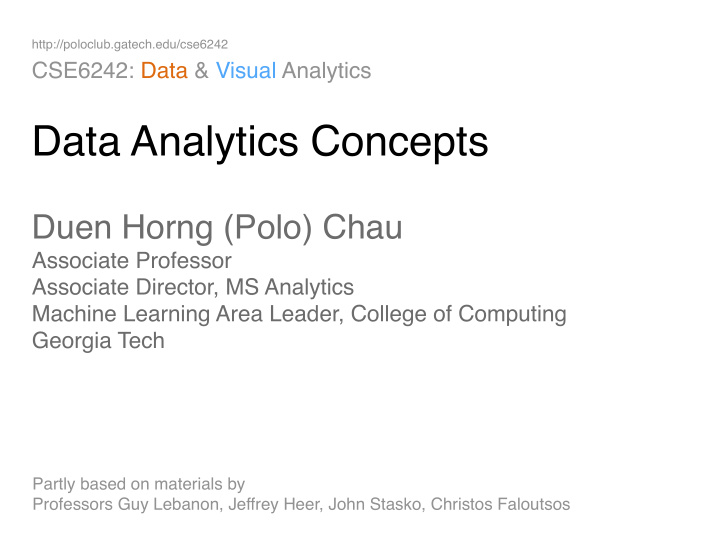



http://poloclub.gatech.edu/cse6242 CSE6242: Data & Visual Analytics Data Analytics Concepts Duen Horng (Polo) Chau Associate Professor Associate Director, MS Analytics Machine Learning Area Leader, College of Computing Georgia Tech Partly based on materials by Professors Guy Lebanon, Jeffrey Heer, John Stasko, Christos Faloutsos
8 concept non-mutually exclusive classes http://www.amazon.com/Data-Science-Business- data-analytic-thinking/dp/1449361323
1. Classification (or Probability Estimation) Predict which of a (small) set of classes an entity belong to. � 3
1. Classification (or Probability Estimation) Predict which of a (small) set of classes an entity belong to. • email spam (y, n) • sentiment analysis (+, -, neutral) • news (politics, sports, …) • medical diagnosis (cancer or not) • shirt size (s, m, l) • cat detection • face detection (baby, middle-aged, etc.) • buy /not buy - commerce � 4
2. Regression (“value estimation”) Predict the numerical value of some variable for an entity. � 5
2. Regression (“value estimation”) Predict the numerical value of some variable for an entity. • point value of wine (50-100) • credit score • stock prices • relationship between price and sales • weather • sports and game scores � 6
3. Similarity Matching Find similar entities (from a large dataset) based on what we know about them. � 7
3. Similarity Matching Find similar entities (from a large dataset) based on what we know about them. • find similar gene sequences (that may be repeating, or does similar things) • online dating • patent search • carpool matching (find people to carpool) � 8
4. Clustering (unsupervised learning) Group entities together by their similarity. (For most algorithms, user provides # of clusters) � 9
4. Clustering (unsupervised learning) Group entities together by their similarity. • groupings of similar bugs in code • topical analysis (tweets?) • land cover: tree/road/… • for advertising: grouping users for marketing purposes • cluster people by accents (y’all, you all) � 10
5. Co-occurrence grouping (Many names: frequent itemset mining, association rule discovery, market-basket analysis) Find associations between entities based on transactions that involve them (e.g., bread and milk often bought together) http://www.forbes.com/sites/kashmirhill/2012/02/16/how-target-figured-out-a-teen-girl- � 11 was-pregnant-before-her-father-did/
6. Profiling / Pattern Mining / Anomaly Detection (unsupervised) Characterize typical behaviors of an entity (person, computer router, etc.) so you can find trends and outliers . • Google sign-in alert • Computer instruction prediction • Removing noisy data (data cleaning) • Detect anomalies in network tra ffi c • Moneyball • Smart security camera � 12
7. Link Prediction / Recommendation Predict if two entities should be connected, and how strongly that link should be. Linkedin/Facebook: people you may know Amazon/Netflix.Pandora: because you like terminator…suggest other movies you may also like � 13
8. Data reduction (“dimensionality reduction”) Shrink a large dataset into smaller one, with as little loss of information as possible 1. if you want to visualize the data (in 2D/3D) 2. faster computation/less storage 3. reduce noise � 14
Start Thinking About Project! • What problems do you want to solve? • Using what large, real datasets? • What techniques do you need? � 15
Recommend
More recommend